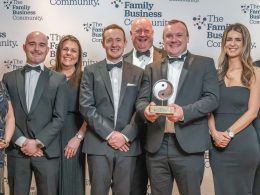By Chris Thomason, Author of ‘Freaky Thinking; Thinking that delivers a dazzling difference’
There isn’t a bean bag or a hoodie to be seen in your office space, and your company sells the world’s dullest widget, so it’s easy to think that creativity plays no part in your business. But that’s not the case. Sooner or later, you’re going to need to engage your imagination – could be in sales, product development, advertising, maintaining staff morale or some other part of your business. There is no escaping the need for creativity.
Wouldn’t it be great if creative thinking and great new ideas just popped up exactly when they were required? But they don’t. You have to make them happen. And to make them happen consistently, you need a process that is easily adopted, and which can be repeated at will. The Freaky Thinking process is a fresh approach to business thinking based on neurological research and the way employees think naturally.
You may believe the most important part of a thinking exercise is getting the ideas which become the answers to your question. But finding the right question initially is far more important; how much use are brilliant answers to the wrong questions?
- Define the Killer Question
- Deconstruct the Killer Question
- Unleash your creativity
- Select the best ideas
- Boost into great concepts
Stage 1: Define the Killer Question
You know you have found your Killer Question when it inspires you, when you recognise that answering it well will produce significant benefits for your organisation, your team, or yourself. A Killer Question ignites genuine curiosity and personal interest in finding great answers. When you reach this point, write down the question in its original form – do not attempt to modify it or you could end up trying to find answers to something else. Just keeping the question in your head can result in drifting away from what fired up your passion for finding answers.
Stage 2: Deconstruct the Killer Question
Regarding the scope and scale of your thinking, it is enticing to want to target everybody (or everything) with a massive change. But most large organisations rarely want a dramatic, radical change – that is often viewed as being too risky. Usually, big things start off small as a way of gauging success.
To deconstruct your Killer Question, think about who and/or what will be affected, and consider the impact level. Will just a few people be involved in the changes, or will it be most staff? Is the scale of the change modest or sizeable – how radical are the changes?
It is often helpful to break down your Killer Question by looking at extremes: a modest change as a way of gauging the impact of much larger changes; or a radical shift likely to disrupt initially and bring huge rewards later. Then consider options occupying the middle ground and also look at combinations.
Stage 3: Unleash your creativity
Inspiration is not guaranteed, no matter how many baths you run. For creativity to happen, your imagination needs a workout. There has to be some effort.
One route to inspiration is to take current ideas and look for fresh combinations. An original idea could be hiding somewhere in the mix, or the originality can be found in the combinations themselves.
Another route is to increase your pool of knowledge by recruiting Pathfinders.
Creative thinking tool: Pathfinders
Your Killer Question may be new to you—and it may be new to your organisation—but is it new to the world? Is this the first time that this question has ever been asked in the history of humanity? Probably not. And if this question has been asked before, then it has likely been answered before. So, the answers to your Killer Questions already exist out there, and you’ve just got to uncover them. This is where Pathfinders can help you.
Pathfinders are individuals who can indirectly help you address your question. They may not have the specific answer, but they show you a path you can take based on their knowledge and experience that may lead you toward a useful solution to your Killer Question. Often, they may not completely understand your question, or the issue that it relates to, so you have to explain it differently for them. You must abstract it so they can understand it more easily. The farther away they are from you and your immediate team, the more you must abstract it to help them. Here is an example:
Imagine you have a team of people who need to work exceptionally long hours to integrate two complex IT systems during a one-week shutdown. You are looking for a good way to reward them for doing this.
5 Pathfinder levels
1. Your own team: How can we reward the integration team at the end of the shutdown? (No abstraction is required for your team).
2. Your department: What have we done well in the past to reward and recognise a team after a difficult shutdown?
3. Your organisation: What interesting ways do you know of to reward or recognise a team for a successful project?
4. Your contacts in other organisations: How does your organisation reward or recognise teams for exceptional effort at work?
5. Your friends & family: What are some unusual ways in which you would like to be rewarded when you have worked hard and done a difficult task really well?
This is a way to get external insights that you can convert into useful ideas, simply by talking to other people.
Stage 4: Select the best ideas
You may have heard of ‘quick-wins’, but this term can sometimes seem a little underwhelming or derogatory. For these small, early-win ideas can often be of more value than bigger ideas.
Win-Quicklies are ideas that can be implemented speedily as proof points for some part of your Killer Question’s final solution. And every organisation likes to see a win quickly to prove that something much larger is feasible. They help minimise risk for the team implementing it, and they help you (as the conceiver of the idea) to see your results sooner. Potentially, you would like to see several Win-Quicklies going live rather than one bigger, slower-moving project.
You assess your Win-Quickly ideas for their effectiveness to prove something and how easy the idea is to deliver. The ideas that rate high on both these measures are the ones you want to progress, whereas ideas that rate low on these measures should be avoided.
Stage 5: Boost into great concepts
You may think that offering a complete and packaged solution to a Killer Question will see you being hailed as a hero by the key stakeholder you are sharing it with. But that is rarely the case. A senior person is likely to have more knowledge than you of activities underway in your organisation that your proposal needs to align with. So be flexible. Sell your concepts as adaptable solutions they can support, shape, and benefit from.
Enter the process accepting that your contributions may be adapted and take pride in the fact that what you came up with formed foundations for the ultimate solution.
Summary
The workplace often wants answers quickly, but spending time initially to focus on getting your Killer Question right—and validated with others—is time well spent. Once defined, chunking it down into targeted and engaging sub-questions makes it easier to answer.









